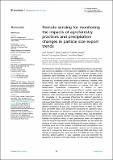Por favor, use este identificador para citar o enlazar a este item:
http://hdl.handle.net/10261/303030COMPARTIR / EXPORTAR:
 SHARE SHARE
 CORE
BASE CORE
BASE
|
|
| Visualizar otros formatos: MARC | Dublin Core | RDF | ORE | MODS | METS | DIDL | DATACITE | |

| Título: | Remote sensing for monitoring the impacts of agroforestry practices and precipitation changes in particle size export trends |
Autor: | Lizaga Villuendas, Iván CSIC ORCID; Latorre Garcés, Borja CSIC ORCID ; Gaspar, Leticia ; Ramos, María Concepción; Navas Izquierdo, Ana CSIC ORCID | Palabras clave: | particle size Remote sensing vegetation indices suspended sediment collectors heavy rainfall events |
Fecha de publicación: | oct-2022 | Editor: | Frontiers Media | Citación: | Lizaga I, Latorre B, Gaspar L, Ramos MC, Navas A.Remote sensing for monitoring the impacts of agroforestry practices and precipitation changes in particle size export trends.Frontiers Earth Science 10: 923447 (2022) | Resumen: | Recent land use changes, the absence of soil protection between crop periods, and extreme precipitation events have been highlighted as major influential factors in the fluctuations of sediment export in the last decades at the catchment scale worldwide. In this regard, soil erosion and fine-particle export are two of the major concerns of soil nutrient loss and water-quality decrease (e.g., increasing turbidity and vector of chemicals). However, while rainfall effects have been well-monitored, recent land use changes and management need additional approaches to evaluate their effect. In Mediterranean mountainous environments, in addition to forest management, agricultural practices during different cropland stages likely increase sediment and particle-bound chemicals in the drainage system. Moreover, most catchments lack instrumentalization. Thus, there is a gap in the knowledge on the processes influencing the sediment exported in ungauged catchments. To evaluate the processes involved, remote sensing and seasonal sampling of suspended sediments were examined for 5 years in a representative agroforestry system in three sub-catchments (SBCs) with different proportions of land uses. Temporal trends of NDVI, EVI, MSAVI, SAVI, and NDWI indices were analyzed for monitoring the vegetation status. With this information, we attempt to evaluate the soil response in terms of particle size export to land use change, vegetation status, and precipitation distribution in fine-grained sediment-reaching streams. Our findings not only highlight the significant effect of heavy precipitation events and vegetation cover on the grain-size fraction of the exported sediment but also reveal the existence of more complex factors influencing the export dynamics. A silt-increasing trend due to the increase of individual heavy precipitations from 2017 onward despite the total precipitation amount not increasing was detected. It is shown that indices such as NDVI and NDMI help detect small changes in vegetation cover, while EVI, SAVI, and MSAVI are more robust for detecting general patterns in large vegetated areas and preventing the appearance of artefacts in the data. Results from this study suggest that land use changes combined with short-scale changing trends of rainfall likely explain most of the possible effects observed in terms of sediment export changes. | Descripción: | 18 Pags.- 8 Figs.- 45 Tabls. © 2022 Lizaga, Latorre, Gaspar, Ramos and Navas. This is an open-access article distributed under the terms of the Creative Commons Attribution License (CC BY). | Versión del editor: | https://doi.org/10.3389/feart.2022.923447 | URI: | http://hdl.handle.net/10261/303030 | DOI: | 10.3389/feart.2022.923447 | E-ISSN: | 2296-6463 |
| Aparece en las colecciones: | (EEAD) Artículos |
Ficheros en este ítem:
| Fichero | Descripción | Tamaño | Formato | |
|---|---|---|---|---|
| LatorreB_FrontEarthSci_2022.pdf | 4,14 MB | Adobe PDF |  Visualizar/Abrir |
CORE Recommender
SCOPUSTM
Citations
3
checked on 08-abr-2024
WEB OF SCIENCETM
Citations
1
checked on 21-feb-2024
Page view(s)
28
checked on 16-abr-2024
Download(s)
41
checked on 16-abr-2024
Google ScholarTM
Check
Altmetric
Altmetric
Este item está licenciado bajo una Licencia Creative Commons



